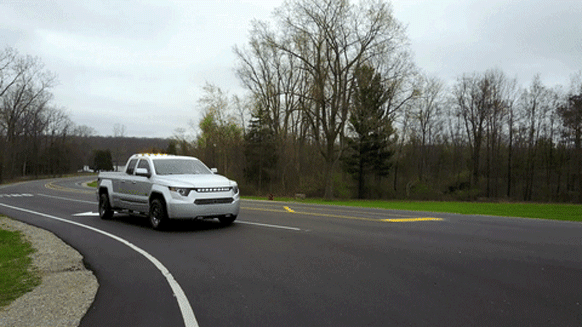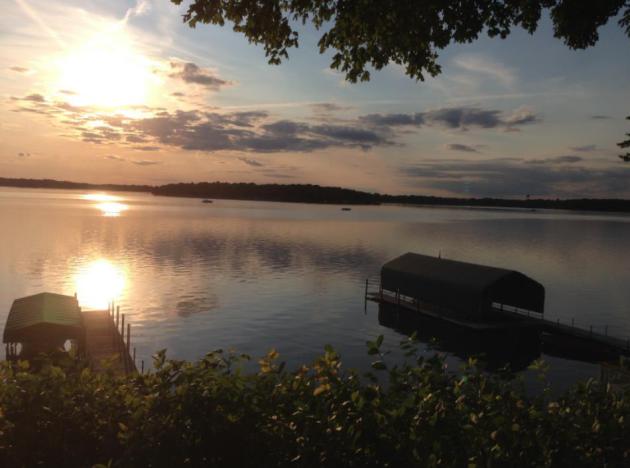65 F. average high on May 4.
66 F. high temperature in the Twin Cities on May 4, 2016.
May 5, 1965: At least 7 tornadoes hit southern Minnesota. This outbreak is a preview of what would happen the next day…
Brush the Cobwebs Off Your Favorite Sunglasses
Is it any coincidence that healthy and wealthy are only one little letter apart? I would argue that if you're healthy, your kids and extended family live nearby - and you have a collection of loyal friends you are wealthy. You may just not realize it yet.
Everyone and everything is interconnected. What happens in the Arctic doesn't stay in the Arctic, either. Is rapid warming and melting impacting the configuration of the jet stream? The science is still emerging, but in the last 20 years I've seen a trend - a tendency toward more "blocking patterns". When weather stalls bad things result, like historic floods or record heat and drought.
A storm stalling over New England for a week means a high pressure bubble stalls above Minnesota, with the nicest weather in America.
You won't want to miss this: highs range from mid-60s to low 70s into Mother's Day with the only chance of a stray thundershower Monday night. Otherwise it's a dry, lukewarm pattern.
A recent parade of storms has set farmers back a few weeks getting into their fields. Dry weather should be the rule the next 2 weeks.

When Weather Gets Stuck. Blocking patterns, atmospheric holding patterns, aren't all that unusual in May, but the one shaping up promises to be super-sized, keeping much of the Northeast and New England cool, damp and showery into mid-May. Severe thunderstorms rumbled into Seattle Thursday but some drying is likely for the Pacific Northwest over the weekend. The best weather: central USA. 12 KM NAM guidance: NOAA and Tropicaltidbits.com.
Map credit: Aeris AMP.
Rains End, But Flooding Dangers Loom if Massive Sierra Snowpack Melts Too Quickly. It's the biggest snowpack for the Sierra Nevada range since 1998, when a massive El Nino created a Pacific storm machine. Here's a clip from The Los Angeles Times: "...The storms that set a rainfall record in Northern California have left a vast layer of mountain snowpack, which now sits at almost 200% of average for the first week of May. In some areas, the snow is 80 feet deep, according to state and NASA reports. Downstream, the rapid snowmelt is keeping public agencies juggling water levels across the state’s network of reservoirs. Water district managers conduct daily conference calls to coordinate how much water each expects to release into California’s labyrinth of rivers, creeks, bypasses and canals..."
Anniversary of May 4, 2007 Greensburg, Kansas EF-5 Tornado. U.S. Tornadoes has a gripping summary of the (unimaginable): "...As the tornado neared the town, it took on the much-feared “wedge” shape, visibly crowding the horizon in the lightning flashes. These are tornadoes that appear wider than they are tall. They’re usually bad news, primarily because they are so huge. Amidst a slew of increasingly urgent warnings, the town of Greensburg prepared as best it could. Life-saving equipment was moved out to wait. The 1,500+ inhabitants of the town were as ready as they could be. Around 9:50 p.m., the tornado that would almost fully destroyed Greensburg began shredding it to bits. The tornado had already been on the ground for almost an hour, and was entering the final part of its 26 mile track. At 1.7 miles in width, the hit would prove unconscionable. Terrible and miraculous all at once, “only” 11 residents lost their lives. Nearly 70 others were injured. The first EF5 on the launched-in-2007 Enhanced Fujita Scale, Greensburg was also the first F/EF5 in the state of Kansas since the Andover tornado of April 26, 1991. It was also the most recent to happen in the state..."
File photo credit: "Marine One flies over tornado damage in Greensburg, Kansas, Wednesday, May 9, 2007." (Charles Dharapak/AP Photo).
Climate Change, Tornadoes and Mobile Homes - A Dangerous Mix. This may be correlated with affordable housing and demographics vs. more tornadoes popping up around the USA. Here's an excerpt at phys.org: "...The annual impact of tornadoes is expected to increase threefold over the next few decades due to the "twin forces of increased climate variability and growth in the human-built environment," according to the study, which is published online in the journal Regional Science and Urban Economics. "If the climatologists are right abouut the continuing effects of climate change," said Mark Skidmore, MSU economics professor and co-author of the study, "then people living in mobile homes could be particularly vulnerable to tornadoes in the years to come."
Photo credit: Michigan State University.
The
annual impact of tornadoes is expected to increase threefold over the
next few decades due to the "twin forces of increased climate
variability and growth in the human-built environment," according to the
study, which is published online in the journal Regional Science and
Urban Economics.
"If the climatologists are right about the continuing effects of climate change," said Mark Skidmore, MSU economics professor and co-author of the study, "then people living in mobile homes could be particularly vulnerable to tornadoes in the years to come."
The researchers investigated underlying factors of tornado fatalities in the U.S. from 1980 to 2014. There were 2,447 tornado-related deaths during that period; the bulk occurred in the "tornado alley" region of the Midwest and Southeast.
Read more at: https://phys.org/news/2017-05-climate-tornadoes-mobile-homesa-dangerous.html#jCp
"If the climatologists are right about the continuing effects of climate change," said Mark Skidmore, MSU economics professor and co-author of the study, "then people living in mobile homes could be particularly vulnerable to tornadoes in the years to come."
The researchers investigated underlying factors of tornado fatalities in the U.S. from 1980 to 2014. There were 2,447 tornado-related deaths during that period; the bulk occurred in the "tornado alley" region of the Midwest and Southeast.
Read more at: https://phys.org/news/2017-05-climate-tornadoes-mobile-homesa-dangerous.html#jCp
As Arctic Ice Vanishes, New Shipping Routes Open. Here's a clip from The New York Times: "As global warming melts sea ice across the Arctic, shipping routes once thought impossible — including directly over the North Pole — may open up by midcentury. But high costs may keep the new routes from being used right away. The amount of sea ice covering the Arctic Ocean has declined sharply each decade since the 1980s, according to measurements taken each September when the ice is at its minimum. Older, thicker ice is disappearing as well. Scientists say global warming is largely responsible for the changes. Parts of the Arctic are warming twice as fast as elsewhere..."
Photo credit: "As groundwater wells run dry, the task of supplying Bangalore’s residents and office parks has been taken up by privately operated tanker trucks." Mahesh Shantaram.

EPA Chief: U.S. Needs Coal to Protect Electric Grid. Here's an excerpt from TheHill: "The head of the Environmental Protection Agency (EPA) argued Wednesday that using coal for electricity is necessary for the reliability of the electric grid. Speaking on Fox Business’s “Varney & Co.,” Scott Pruitt warned of the problems of relying too heavily on natural gas, which has increased in use over the last decade as coal has fallen. Pruitt argued in part that cybersecurity concerns should inspire the country to maintain coal as a significant fuel source. “Utility companies across this country need fuel diversity. You need solid hydrocarbons on-site that you can store, so when peak demand rises, you’ve got solid hydrocarbons to draw on,” Pruitt told host Charles Payne..." (File image: Reuters).

Driving Chevrolet Bolt Makes TIME Writer an Electric Car Believer....Maybe. Here's an excerpt from insideevs.com: "...He points out that though environmentalists have been touting such vehicles for quite some time, the electric car just wasn’t practical. Short range vehicles that were way too expensive, just didn’t appeal to the masses. The Chevrolet Bolt is the first car to truly change this. So, it will be awhile before the general population starts to realize, but it’s imminent. We are finding more and more of these reviews, in which a general publication, or a non-automotive writer is pleasantly surprised by the Chevrolet Bolt. This is outstanding for the segment, because we all know that the average Joe or Jane is probably not reading about EVs on a regular basis. Fitzpatrick says that once you get past all the futuristic visions, the Chevrolet Bolt feels just like you’re driving any other sporty crossover..."
The Idea of "One True Calling" is a Romanticized Lie. New research suggests today's 20-somethings will have 2-3 different careers and 1-2 DOZEN different "jobs". A story at Quartz seems to confirm that notion: "...There is no single way to be a multipotentialite. Some of us have a dozen projects on the go at once, others prefer to dive into a single subject for months or years, making it our sole focus until we switch to a new area entirely. A multipotentialite’s interests can occur simultaneously (several interests at one time), sequentially (one interest at a time), or anywhere in between. To figure out your own place on this spectrum, think about your past interests, projects, and jobs. Notice any patterns? Do you tend to be interested in many different topics at once, or do you prefer to focus intently on one thing at a time before moving on to the next one (and then the next)? How many projects do you like to have on your plate at once, and how many is too many?..."
Photo credit: "Why play one instrument when you can play eleven?" (Reuters/Carlo Allegri).
Image credit: Kevin Tong.
TODAY: Lukewarm sunshine. Late PM shower risk over Wisconsin. Winds: NW 8-13. High: 74
FRIDAY NIGHT: Mostly clear. Low: 47
SATURDAY: Plenty of sun, a bit cooler. Winds: NE 8-13. High: 63
SUNDAY: Sunny and very nice. Winds: SE 7-12. Wake-up: 43. High: 66
MONDAY: Fading sun, stray T-shower late? Winds: SE 10-15. Wake-up: 47. High: near 70
TUESDAY: Peeks of sun, isolated shower risk. Winds: NW 5-10. Wake-up: 53. High: 73
WEDNESDAY: More sun, few complaints. Winds: NE 7-12. Wake-up: 49. High: 69
THURSDAY: Lot's of sun, still spectacular. Winds: NE 5-10. Wake-up: 46. High: 71
Climate Stories...
Image credit: A list of members of the bipartisan Climate Solutions Caucus in Washington D.C. is available at Citizens Climate Lobby.



.jpg)
Is the Climate Consensus 97%, 99.9% or is Plate Tectonics a Hoax? Follow the logic carefully in a post at The Guardian: "...Lamar Smith also referenced a common denier argument that consensus should be measured by comparing the number of papers explicitly endorsing the theory to the total number of papers examined. By that measure, 0 out of 331 geology papers endorsed the theory, meaning the consensus is 0% and clearly plate tectonics is a hoax. Ultimately those are our three options in defining the climate “consensus.” Either every paper that doesn’t explicitly reject human-caused global warming is part of the 99.9% consensus, or 97% of papers taking a position on the cause of global warming are part of the consensus endorsing the theory, or climate science and plate tectonics are both hoaxes. It’s most accurate to say that 97% of relevant peer-reviewed studies agree that humans are causing global warming, 99.9% of climate papers don’t reject that theory, and those who deny the overwhelming consensus are peddling misinformation..."
No comments:
Post a Comment